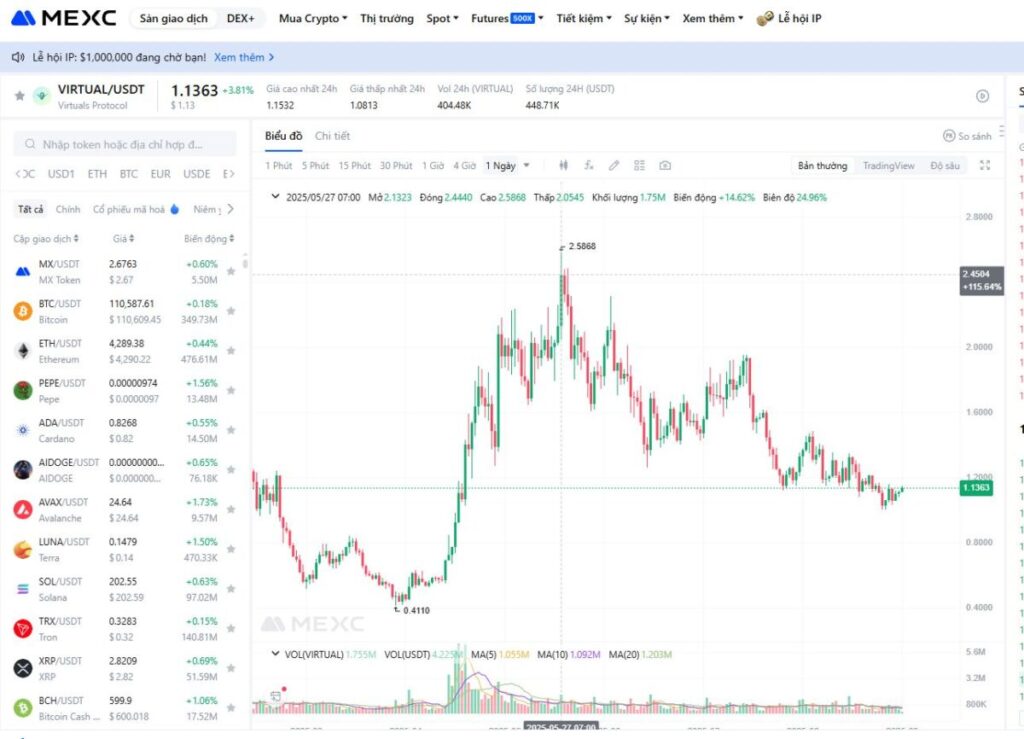Hedging is a strategy that helps investors protect their assets against unexpected market volatility. In crypto — where price swings are often brutal — understanding and applying hedging becomes extremely important. So, what exactly is hedging, and which methods are most effective for protecting your portfolio?
1.What is Hedging?
Hedging is a risk management strategy designed to minimize or offset potential losses from unfavorable market moves. This can be done through different tools such as futures, derivatives, or even insurance products.
The goal of hedging is not to maximize profit but to reduce downside risk. Think of it like buying insurance: you don’t want to use it, but it’s there to protect you when things go wrong.
2.Why Use Hedging in Crypto?
2.1 Reacting to Price Volatility
Crypto is notorious for wild price swings. That’s why many investors treat hedging as a form of price insurance.
Example: Virtual Protocol recently launched a Genesis Launchpad campaign where users could stake $VIRTUAL to earn points and secure IDO allocation rights. But the token was locked during staking. If someone bought $VIRTUAL at a high entry price, they risked a loss once staking unlocked. In this case, hedging with a short position would protect potential profits.

2.2 Protecting Profits Without Selling
One of the most common uses of hedging is locking in gains without having to sell your spot holdings.
Example: MEXC often hosts launchpads for attractive new projects, but to participate, users need $MX. Right before a launchpad, $MX usually pumps due to FOMO, then drops slightly afterward. If you buy $MX at a high price to join, you can hedge by shorting the same amount of $MX. That way, even if the price corrects, your short position offsets the loss — leaving you with optimal exposure and launchpad access.
2.3 Hedging an Entire Portfolio
Altcoins are usually more volatile than $BTC or $ETH. Let’s say you hold a $50,000 portfolio with $VIRTUAL, $OP, $SEI, and $SUI. If $BTC dumps 10%, these alts might crash 20–30%, causing heavy losses.
Instead of shorting each alt (which may lack liquidity), you can open a $25,000 short on $BTC. If $BTC drops 10%, your altcoin bag might lose ~$10,000, but the $BTC short makes ~$2,500, cushioning the overall damage.
This is called a cross-asset hedge — using a major asset ($BTC or $ETH) to hedge a portfolio of correlated smaller tokens.
2.4 Ensuring Liquidity & Covering Financial Obligations
Hedging isn’t just for retail — funds and projects use it too.
Example: A fund raises 10,000 $ETH (~$43M) for operations, but their expenses (salaries, infra) are in USD. If ETH price drops, their budget shrinks drastically. To prevent this, they short ETH futures equal to their holdings.
When ETH falls from $4,300 to $3,800, they lose $5M on spot but gain $5M on futures. Net assets remain at $35M, ensuring stable cashflow to cover obligations regardless of ETH price moves.
3.Effective Hedging Methods in Crypto
3.1 Futures Contracts
The simplest and most widely used method. You open a short futures position equal to your spot exposure. This locks in profits or limits downside risk.
The key is choosing a reliable exchange with high liquidity and fair fees. For example, MEXC offers deep liquidity and some of the lowest funding rates in the market, making futures hedging more cost-efficient.

3.2 Options Hedging
Options give you the right (but not obligation) to buy (call) or sell (put) an asset at a set price within a timeframe. This lets you limit downside risk while keeping upside exposure.
Example: An investor fears $ETH might drop. They buy put options, which allow them to sell $ETH at a higher strike price even if the market crashes. If $ETH dips, the put gains value and offsets losses.
Options add flexibility, but they require upfront costs (premiums) and solid understanding of timing and strike selection.
3.3 Crypto Insurance
Still a relatively new niche, crypto insurance helps protect against risks like hacks, protocol failures, or smart contract exploits.
Example: A large investor can buy insurance for their DeFi position, ensuring reimbursement if the protocol gets hacked.
Insurance reduces black swan risk, though coverage costs and reliability of providers remain challenges. Unlike traditional markets, crypto insurance lacks standardized pricing or frameworks.
4.Challenges of Hedging in Crypto
- Limited tools: Traditional hedging instruments aren’t as developed in crypto, making strategies less accessible.
- Knowledge barrier: Effective hedging requires strong market understanding, risk assessment skills, and familiarity with complex financial instruments.
- Cost factor: Hedging isn’t free — futures funding fees, options premiums, or insurance costs must be balanced against potential risk.
5.Conclusion
In crypto, hedging is less about making money and more about staying in the game. Whether you’re a retail trader or a fund, applying the right hedging strategy can mean the difference between surviving volatility or getting wiped out.
Disclaimer: This content does not provide investment, tax, legal, financial, or accounting advice. MEXC shares information purely for educational purposes. Always DYOR, understand the risks, and invest responsibly.
.
Join MEXC and Get up to $10,000 Bonus!
Sign Up


